Analysis of Social Work Policy and Law: Child Protection in QLD
VerifiedAdded on 2023/06/11
|16
|3792
|480
Report
AI Summary
This report addresses issues related to the implementation of recommendations from the Royal Commission regarding child safeguarding against sexual abuse in Queensland. It identifies the involvement of institutions like churches and children's homes in child sexual abuse, highlighting a specific case within the Salvation Army. The report discusses the Royal Commission's inquiry into institutional responses to child sexual abuse and its subsequent recommendations for improving child safety standards. It proposes a new policy emphasizing institutional governance, culture, and mandatory reporting procedures. The report stresses the importance of state government and judiciary involvement in policy implementation, including considering failures to safeguard children as criminal offenses and extending grooming laws. Consultation with stakeholders, including young people and institution authorities, is recommended to enhance policy effectiveness. Continuous review and improvement of child safety standards are essential for ensuring child protection.

Running head: SOCIAL WORK POLICY AND LAW
Social Work Policy and Law
Name of the Student
Name of the University
Author Note
Social Work Policy and Law
Name of the Student
Name of the University
Author Note
Paraphrase This Document
Need a fresh take? Get an instant paraphrase of this document with our AI Paraphraser
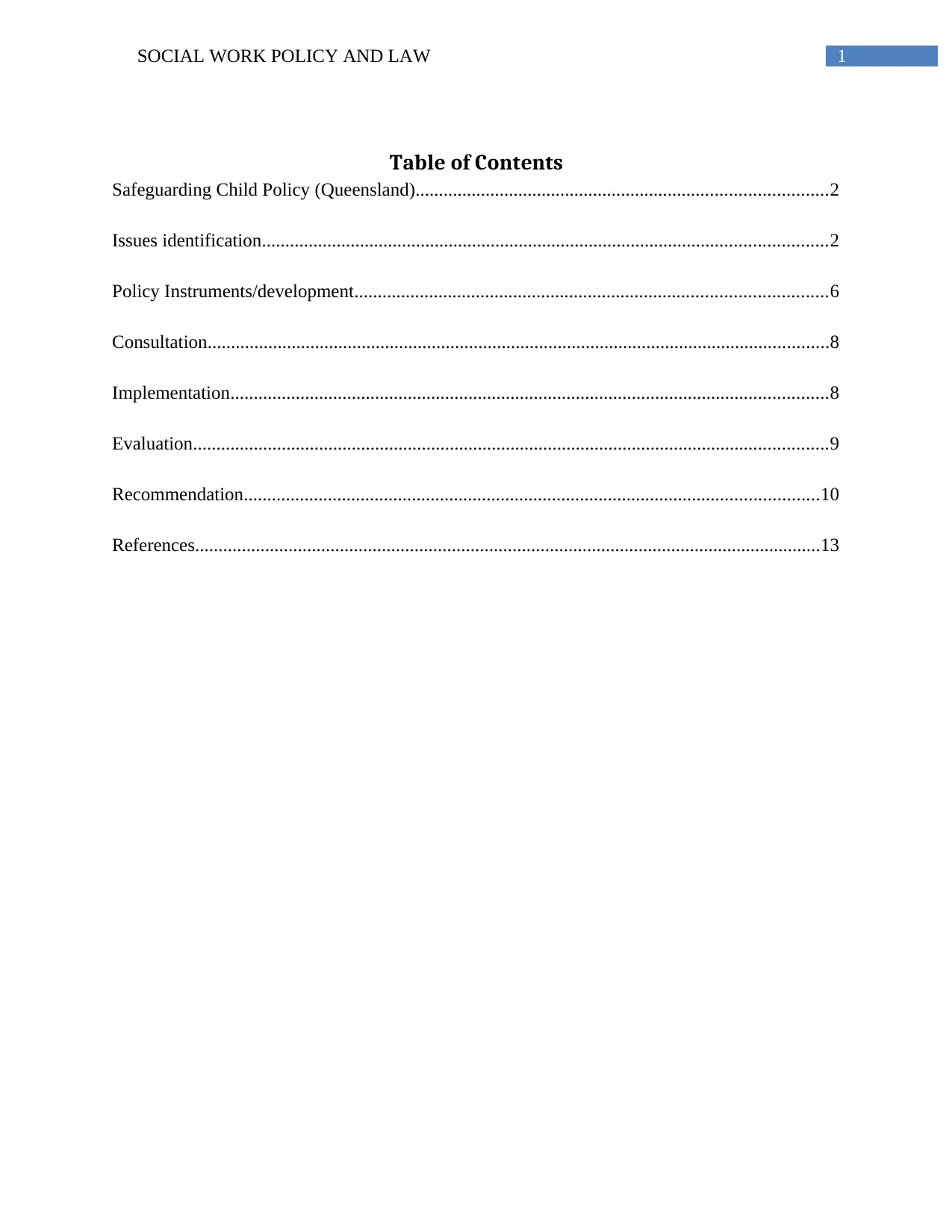
1SOCIAL WORK POLICY AND LAW
Table of Contents
Safeguarding Child Policy (Queensland)........................................................................................2
Issues identification.........................................................................................................................2
Policy Instruments/development.....................................................................................................6
Consultation.....................................................................................................................................8
Implementation................................................................................................................................8
Evaluation........................................................................................................................................9
Recommendation...........................................................................................................................10
References......................................................................................................................................13
Table of Contents
Safeguarding Child Policy (Queensland)........................................................................................2
Issues identification.........................................................................................................................2
Policy Instruments/development.....................................................................................................6
Consultation.....................................................................................................................................8
Implementation................................................................................................................................8
Evaluation........................................................................................................................................9
Recommendation...........................................................................................................................10
References......................................................................................................................................13
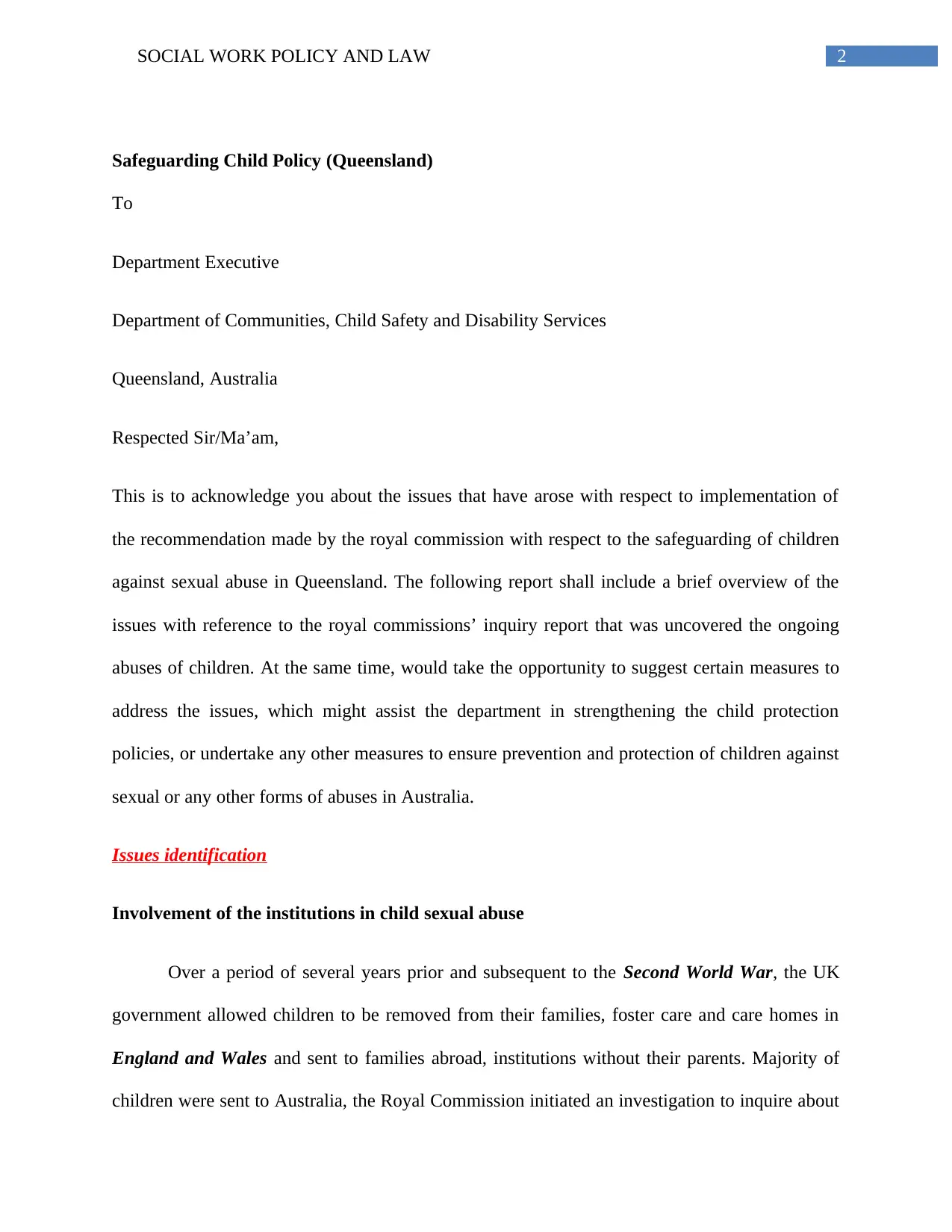
2SOCIAL WORK POLICY AND LAW
Safeguarding Child Policy (Queensland)
To
Department Executive
Department of Communities, Child Safety and Disability Services
Queensland, Australia
Respected Sir/Ma’am,
This is to acknowledge you about the issues that have arose with respect to implementation of
the recommendation made by the royal commission with respect to the safeguarding of children
against sexual abuse in Queensland. The following report shall include a brief overview of the
issues with reference to the royal commissions’ inquiry report that was uncovered the ongoing
abuses of children. At the same time, would take the opportunity to suggest certain measures to
address the issues, which might assist the department in strengthening the child protection
policies, or undertake any other measures to ensure prevention and protection of children against
sexual or any other forms of abuses in Australia.
Issues identification
Involvement of the institutions in child sexual abuse
Over a period of several years prior and subsequent to the Second World War, the UK
government allowed children to be removed from their families, foster care and care homes in
England and Wales and sent to families abroad, institutions without their parents. Majority of
children were sent to Australia, the Royal Commission initiated an investigation to inquire about
Safeguarding Child Policy (Queensland)
To
Department Executive
Department of Communities, Child Safety and Disability Services
Queensland, Australia
Respected Sir/Ma’am,
This is to acknowledge you about the issues that have arose with respect to implementation of
the recommendation made by the royal commission with respect to the safeguarding of children
against sexual abuse in Queensland. The following report shall include a brief overview of the
issues with reference to the royal commissions’ inquiry report that was uncovered the ongoing
abuses of children. At the same time, would take the opportunity to suggest certain measures to
address the issues, which might assist the department in strengthening the child protection
policies, or undertake any other measures to ensure prevention and protection of children against
sexual or any other forms of abuses in Australia.
Issues identification
Involvement of the institutions in child sexual abuse
Over a period of several years prior and subsequent to the Second World War, the UK
government allowed children to be removed from their families, foster care and care homes in
England and Wales and sent to families abroad, institutions without their parents. Majority of
children were sent to Australia, the Royal Commission initiated an investigation to inquire about
⊘ This is a preview!⊘
Do you want full access?
Subscribe today to unlock all pages.

Trusted by 1+ million students worldwide

3SOCIAL WORK POLICY AND LAW
the experiences of such migrant children, and the measures that have been undertaken by the
institutions to exercise reasonable care towards the vulnerable children, which includes orphans,
migrant, protecting them from being sexually abused (Wright, Swain & McPhillips, 22017).
The sexual abuse of children in the context of institutions has been a major concern of the
policy-makers, public and practitioners. This policy proposal refers to the social service
institutions like churches and children shelter homes, which are conferred with the responsibility
to safeguard the vulnerable children, are the ones involved in such heinous criminal offences.
Unfortunately, any institution that permits unsupervised and frequent adult access to the children
are the ones with certain percentage of adults infringing the trust by subjecting the youth to
sexual abuse. The incident of sexual exploitation amongst vulnerable children and youths by the
adults is common in educational, extracurricular and religious organizations under the pretense
of rendering services to children and youths (Middleton et al., 2014).
However, subsequent to the inquiry made by the Royal Commission, it was revealed the
several churches and homes were involved in committing sexual offences against the vulnerable
children and even prevented them from reporting about the abuse. Nevertheless, several
legislations have been enacted along with new initiatives have been undertaken by the Australian
state governments to ensure implementation of the Royal Commission recommendation
regarding child safeguards (Tarr & Nicholson, 2017).
Evidence of existence of the problem
In Queensland, the issues related to sexual abuse committed by the institutions have been
highlighted after the inquiry of the Royal Commission. One of such case of sexual abuse by
the experiences of such migrant children, and the measures that have been undertaken by the
institutions to exercise reasonable care towards the vulnerable children, which includes orphans,
migrant, protecting them from being sexually abused (Wright, Swain & McPhillips, 22017).
The sexual abuse of children in the context of institutions has been a major concern of the
policy-makers, public and practitioners. This policy proposal refers to the social service
institutions like churches and children shelter homes, which are conferred with the responsibility
to safeguard the vulnerable children, are the ones involved in such heinous criminal offences.
Unfortunately, any institution that permits unsupervised and frequent adult access to the children
are the ones with certain percentage of adults infringing the trust by subjecting the youth to
sexual abuse. The incident of sexual exploitation amongst vulnerable children and youths by the
adults is common in educational, extracurricular and religious organizations under the pretense
of rendering services to children and youths (Middleton et al., 2014).
However, subsequent to the inquiry made by the Royal Commission, it was revealed the
several churches and homes were involved in committing sexual offences against the vulnerable
children and even prevented them from reporting about the abuse. Nevertheless, several
legislations have been enacted along with new initiatives have been undertaken by the Australian
state governments to ensure implementation of the Royal Commission recommendation
regarding child safeguards (Tarr & Nicholson, 2017).
Evidence of existence of the problem
In Queensland, the issues related to sexual abuse committed by the institutions have been
highlighted after the inquiry of the Royal Commission. One of such case of sexual abuse by
Paraphrase This Document
Need a fresh take? Get an instant paraphrase of this document with our AI Paraphraser
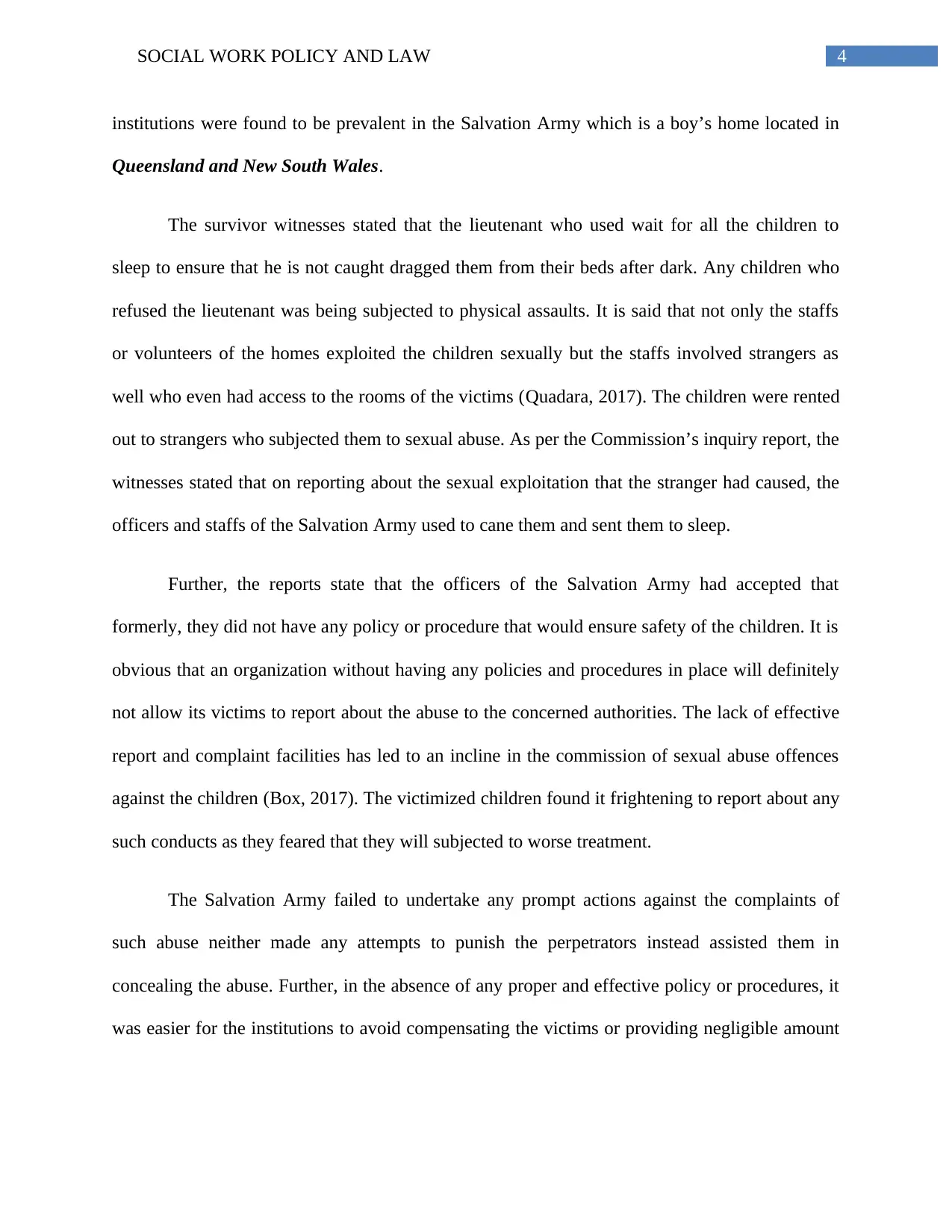
4SOCIAL WORK POLICY AND LAW
institutions were found to be prevalent in the Salvation Army which is a boy’s home located in
Queensland and New South Wales.
The survivor witnesses stated that the lieutenant who used wait for all the children to
sleep to ensure that he is not caught dragged them from their beds after dark. Any children who
refused the lieutenant was being subjected to physical assaults. It is said that not only the staffs
or volunteers of the homes exploited the children sexually but the staffs involved strangers as
well who even had access to the rooms of the victims (Quadara, 2017). The children were rented
out to strangers who subjected them to sexual abuse. As per the Commission’s inquiry report, the
witnesses stated that on reporting about the sexual exploitation that the stranger had caused, the
officers and staffs of the Salvation Army used to cane them and sent them to sleep.
Further, the reports state that the officers of the Salvation Army had accepted that
formerly, they did not have any policy or procedure that would ensure safety of the children. It is
obvious that an organization without having any policies and procedures in place will definitely
not allow its victims to report about the abuse to the concerned authorities. The lack of effective
report and complaint facilities has led to an incline in the commission of sexual abuse offences
against the children (Box, 2017). The victimized children found it frightening to report about any
such conducts as they feared that they will subjected to worse treatment.
The Salvation Army failed to undertake any prompt actions against the complaints of
such abuse neither made any attempts to punish the perpetrators instead assisted them in
concealing the abuse. Further, in the absence of any proper and effective policy or procedures, it
was easier for the institutions to avoid compensating the victims or providing negligible amount
institutions were found to be prevalent in the Salvation Army which is a boy’s home located in
Queensland and New South Wales.
The survivor witnesses stated that the lieutenant who used wait for all the children to
sleep to ensure that he is not caught dragged them from their beds after dark. Any children who
refused the lieutenant was being subjected to physical assaults. It is said that not only the staffs
or volunteers of the homes exploited the children sexually but the staffs involved strangers as
well who even had access to the rooms of the victims (Quadara, 2017). The children were rented
out to strangers who subjected them to sexual abuse. As per the Commission’s inquiry report, the
witnesses stated that on reporting about the sexual exploitation that the stranger had caused, the
officers and staffs of the Salvation Army used to cane them and sent them to sleep.
Further, the reports state that the officers of the Salvation Army had accepted that
formerly, they did not have any policy or procedure that would ensure safety of the children. It is
obvious that an organization without having any policies and procedures in place will definitely
not allow its victims to report about the abuse to the concerned authorities. The lack of effective
report and complaint facilities has led to an incline in the commission of sexual abuse offences
against the children (Box, 2017). The victimized children found it frightening to report about any
such conducts as they feared that they will subjected to worse treatment.
The Salvation Army failed to undertake any prompt actions against the complaints of
such abuse neither made any attempts to punish the perpetrators instead assisted them in
concealing the abuse. Further, in the absence of any proper and effective policy or procedures, it
was easier for the institutions to avoid compensating the victims or providing negligible amount
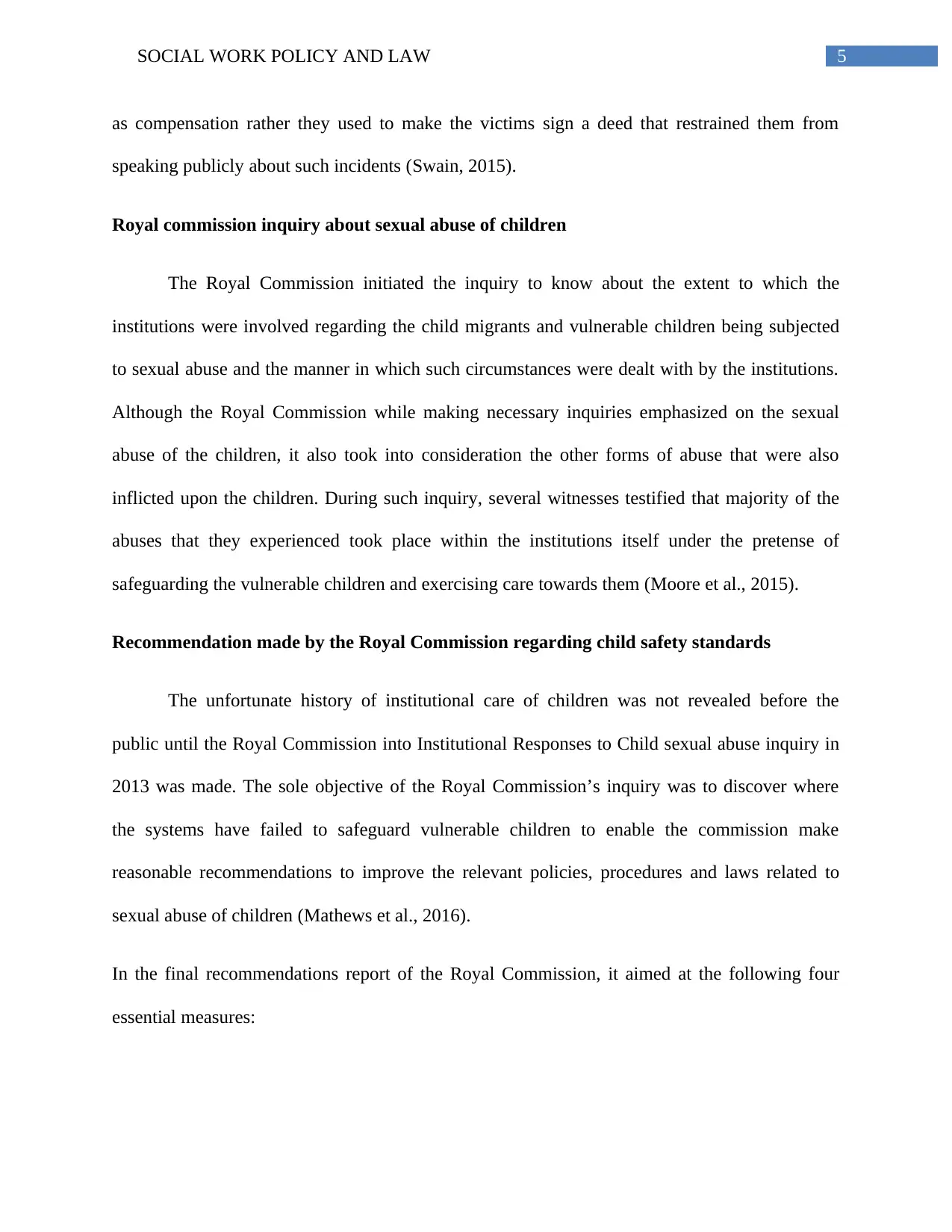
5SOCIAL WORK POLICY AND LAW
as compensation rather they used to make the victims sign a deed that restrained them from
speaking publicly about such incidents (Swain, 2015).
Royal commission inquiry about sexual abuse of children
The Royal Commission initiated the inquiry to know about the extent to which the
institutions were involved regarding the child migrants and vulnerable children being subjected
to sexual abuse and the manner in which such circumstances were dealt with by the institutions.
Although the Royal Commission while making necessary inquiries emphasized on the sexual
abuse of the children, it also took into consideration the other forms of abuse that were also
inflicted upon the children. During such inquiry, several witnesses testified that majority of the
abuses that they experienced took place within the institutions itself under the pretense of
safeguarding the vulnerable children and exercising care towards them (Moore et al., 2015).
Recommendation made by the Royal Commission regarding child safety standards
The unfortunate history of institutional care of children was not revealed before the
public until the Royal Commission into Institutional Responses to Child sexual abuse inquiry in
2013 was made. The sole objective of the Royal Commission’s inquiry was to discover where
the systems have failed to safeguard vulnerable children to enable the commission make
reasonable recommendations to improve the relevant policies, procedures and laws related to
sexual abuse of children (Mathews et al., 2016).
In the final recommendations report of the Royal Commission, it aimed at the following four
essential measures:
as compensation rather they used to make the victims sign a deed that restrained them from
speaking publicly about such incidents (Swain, 2015).
Royal commission inquiry about sexual abuse of children
The Royal Commission initiated the inquiry to know about the extent to which the
institutions were involved regarding the child migrants and vulnerable children being subjected
to sexual abuse and the manner in which such circumstances were dealt with by the institutions.
Although the Royal Commission while making necessary inquiries emphasized on the sexual
abuse of the children, it also took into consideration the other forms of abuse that were also
inflicted upon the children. During such inquiry, several witnesses testified that majority of the
abuses that they experienced took place within the institutions itself under the pretense of
safeguarding the vulnerable children and exercising care towards them (Moore et al., 2015).
Recommendation made by the Royal Commission regarding child safety standards
The unfortunate history of institutional care of children was not revealed before the
public until the Royal Commission into Institutional Responses to Child sexual abuse inquiry in
2013 was made. The sole objective of the Royal Commission’s inquiry was to discover where
the systems have failed to safeguard vulnerable children to enable the commission make
reasonable recommendations to improve the relevant policies, procedures and laws related to
sexual abuse of children (Mathews et al., 2016).
In the final recommendations report of the Royal Commission, it aimed at the following four
essential measures:
⊘ This is a preview!⊘
Do you want full access?
Subscribe today to unlock all pages.

Trusted by 1+ million students worldwide
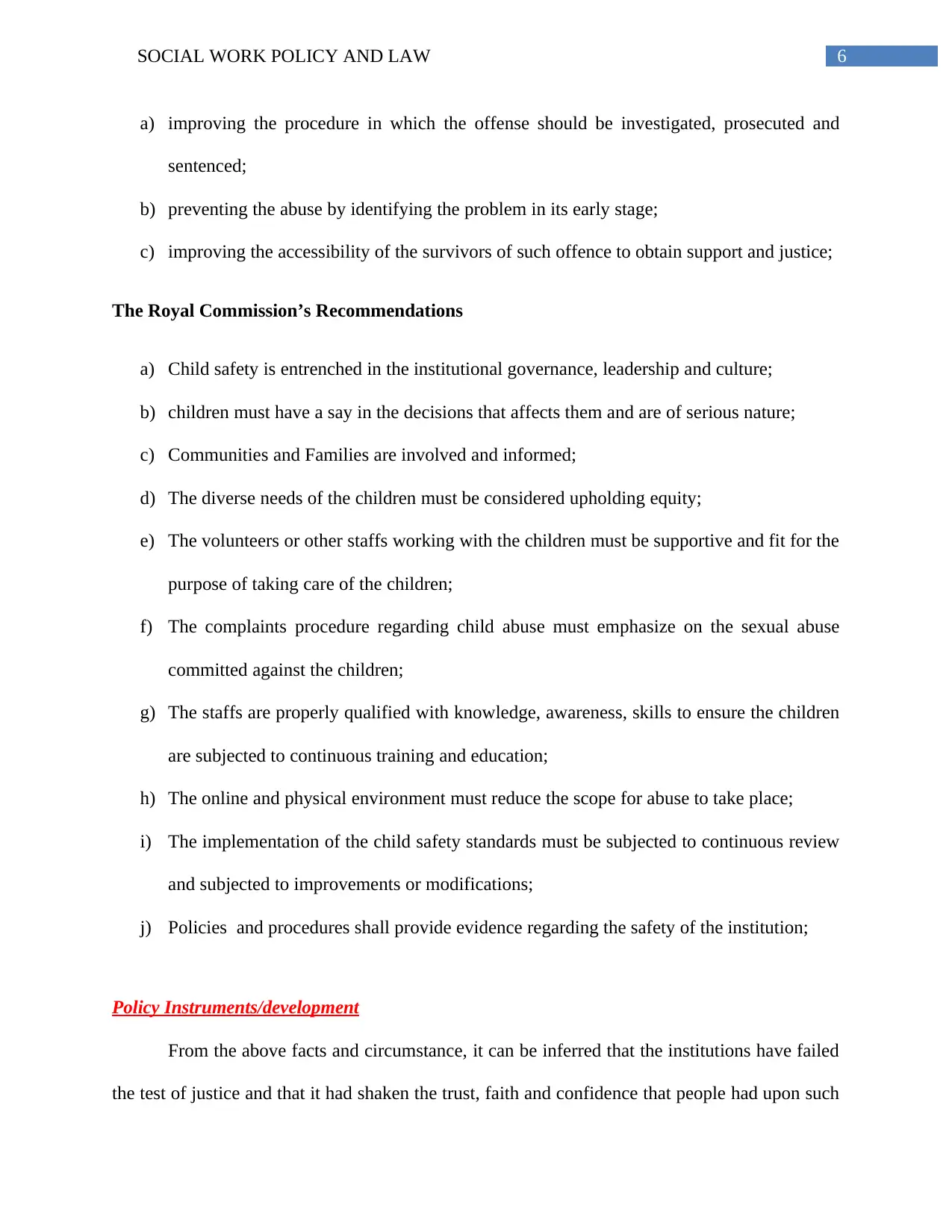
6SOCIAL WORK POLICY AND LAW
a) improving the procedure in which the offense should be investigated, prosecuted and
sentenced;
b) preventing the abuse by identifying the problem in its early stage;
c) improving the accessibility of the survivors of such offence to obtain support and justice;
The Royal Commission’s Recommendations
a) Child safety is entrenched in the institutional governance, leadership and culture;
b) children must have a say in the decisions that affects them and are of serious nature;
c) Communities and Families are involved and informed;
d) The diverse needs of the children must be considered upholding equity;
e) The volunteers or other staffs working with the children must be supportive and fit for the
purpose of taking care of the children;
f) The complaints procedure regarding child abuse must emphasize on the sexual abuse
committed against the children;
g) The staffs are properly qualified with knowledge, awareness, skills to ensure the children
are subjected to continuous training and education;
h) The online and physical environment must reduce the scope for abuse to take place;
i) The implementation of the child safety standards must be subjected to continuous review
and subjected to improvements or modifications;
j) Policies and procedures shall provide evidence regarding the safety of the institution;
Policy Instruments/development
From the above facts and circumstance, it can be inferred that the institutions have failed
the test of justice and that it had shaken the trust, faith and confidence that people had upon such
a) improving the procedure in which the offense should be investigated, prosecuted and
sentenced;
b) preventing the abuse by identifying the problem in its early stage;
c) improving the accessibility of the survivors of such offence to obtain support and justice;
The Royal Commission’s Recommendations
a) Child safety is entrenched in the institutional governance, leadership and culture;
b) children must have a say in the decisions that affects them and are of serious nature;
c) Communities and Families are involved and informed;
d) The diverse needs of the children must be considered upholding equity;
e) The volunteers or other staffs working with the children must be supportive and fit for the
purpose of taking care of the children;
f) The complaints procedure regarding child abuse must emphasize on the sexual abuse
committed against the children;
g) The staffs are properly qualified with knowledge, awareness, skills to ensure the children
are subjected to continuous training and education;
h) The online and physical environment must reduce the scope for abuse to take place;
i) The implementation of the child safety standards must be subjected to continuous review
and subjected to improvements or modifications;
j) Policies and procedures shall provide evidence regarding the safety of the institution;
Policy Instruments/development
From the above facts and circumstance, it can be inferred that the institutions have failed
the test of justice and that it had shaken the trust, faith and confidence that people had upon such
Paraphrase This Document
Need a fresh take? Get an instant paraphrase of this document with our AI Paraphraser
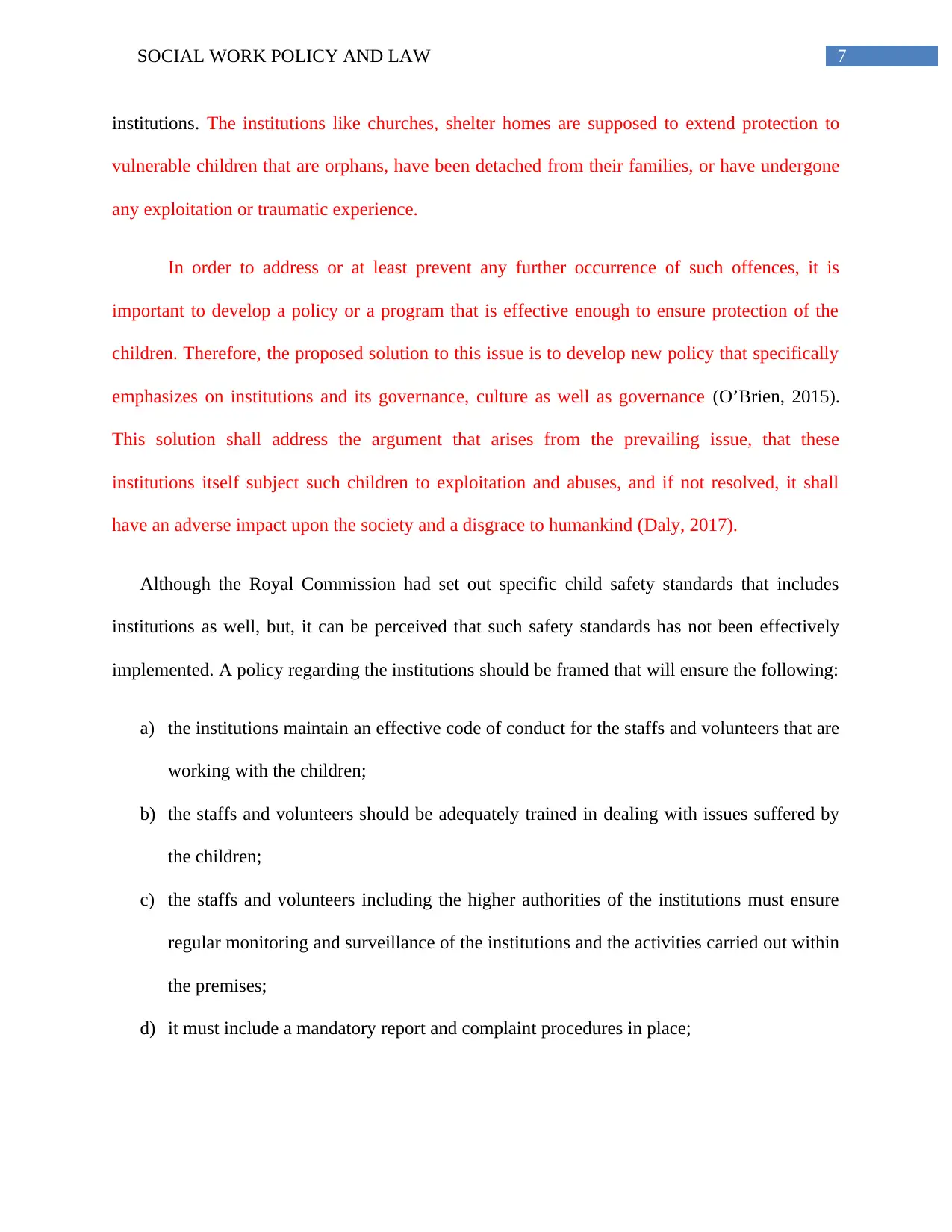
7SOCIAL WORK POLICY AND LAW
institutions. The institutions like churches, shelter homes are supposed to extend protection to
vulnerable children that are orphans, have been detached from their families, or have undergone
any exploitation or traumatic experience.
In order to address or at least prevent any further occurrence of such offences, it is
important to develop a policy or a program that is effective enough to ensure protection of the
children. Therefore, the proposed solution to this issue is to develop new policy that specifically
emphasizes on institutions and its governance, culture as well as governance (O’Brien, 2015).
This solution shall address the argument that arises from the prevailing issue, that these
institutions itself subject such children to exploitation and abuses, and if not resolved, it shall
have an adverse impact upon the society and a disgrace to humankind (Daly, 2017).
Although the Royal Commission had set out specific child safety standards that includes
institutions as well, but, it can be perceived that such safety standards has not been effectively
implemented. A policy regarding the institutions should be framed that will ensure the following:
a) the institutions maintain an effective code of conduct for the staffs and volunteers that are
working with the children;
b) the staffs and volunteers should be adequately trained in dealing with issues suffered by
the children;
c) the staffs and volunteers including the higher authorities of the institutions must ensure
regular monitoring and surveillance of the institutions and the activities carried out within
the premises;
d) it must include a mandatory report and complaint procedures in place;
institutions. The institutions like churches, shelter homes are supposed to extend protection to
vulnerable children that are orphans, have been detached from their families, or have undergone
any exploitation or traumatic experience.
In order to address or at least prevent any further occurrence of such offences, it is
important to develop a policy or a program that is effective enough to ensure protection of the
children. Therefore, the proposed solution to this issue is to develop new policy that specifically
emphasizes on institutions and its governance, culture as well as governance (O’Brien, 2015).
This solution shall address the argument that arises from the prevailing issue, that these
institutions itself subject such children to exploitation and abuses, and if not resolved, it shall
have an adverse impact upon the society and a disgrace to humankind (Daly, 2017).
Although the Royal Commission had set out specific child safety standards that includes
institutions as well, but, it can be perceived that such safety standards has not been effectively
implemented. A policy regarding the institutions should be framed that will ensure the following:
a) the institutions maintain an effective code of conduct for the staffs and volunteers that are
working with the children;
b) the staffs and volunteers should be adequately trained in dealing with issues suffered by
the children;
c) the staffs and volunteers including the higher authorities of the institutions must ensure
regular monitoring and surveillance of the institutions and the activities carried out within
the premises;
d) it must include a mandatory report and complaint procedures in place;
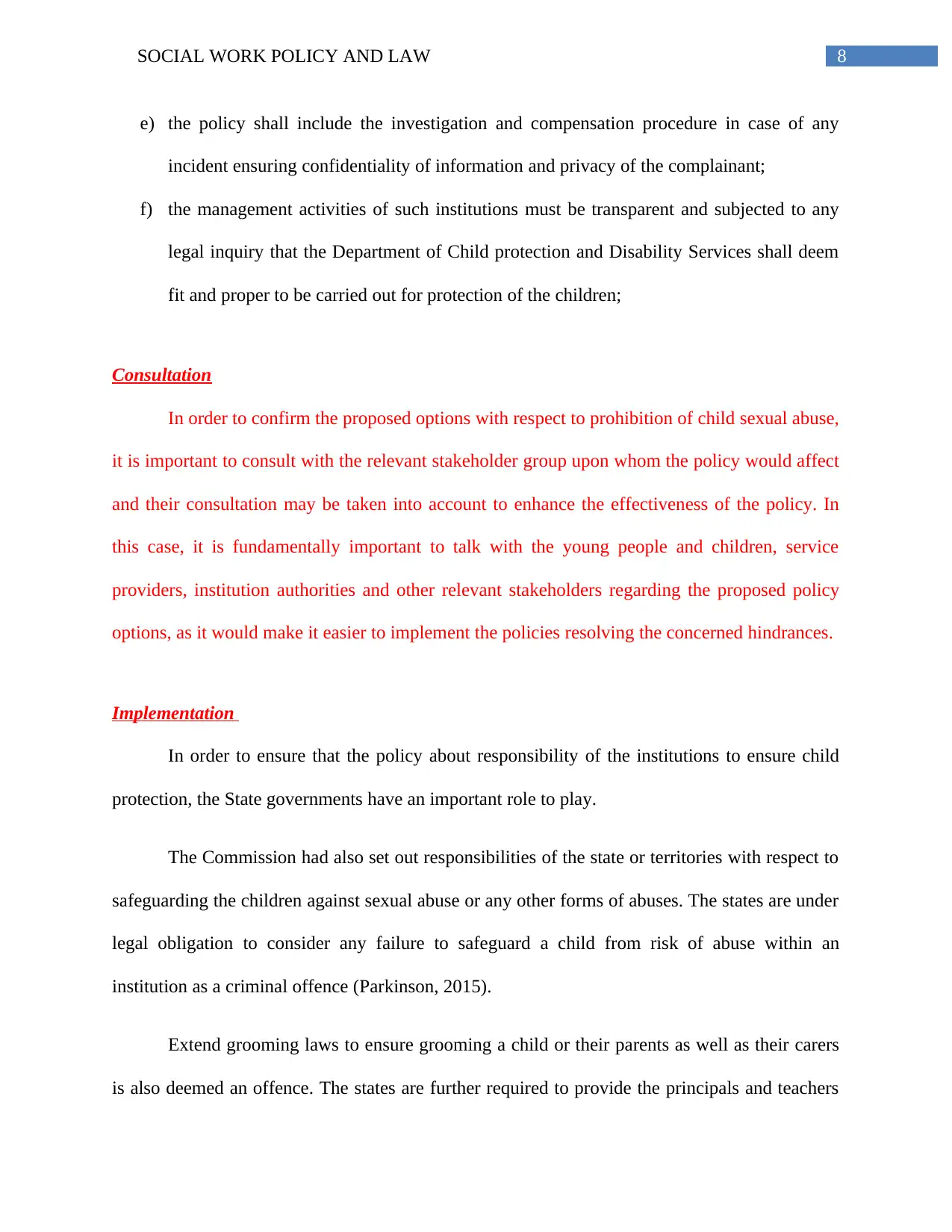
8SOCIAL WORK POLICY AND LAW
e) the policy shall include the investigation and compensation procedure in case of any
incident ensuring confidentiality of information and privacy of the complainant;
f) the management activities of such institutions must be transparent and subjected to any
legal inquiry that the Department of Child protection and Disability Services shall deem
fit and proper to be carried out for protection of the children;
Consultation
In order to confirm the proposed options with respect to prohibition of child sexual abuse,
it is important to consult with the relevant stakeholder group upon whom the policy would affect
and their consultation may be taken into account to enhance the effectiveness of the policy. In
this case, it is fundamentally important to talk with the young people and children, service
providers, institution authorities and other relevant stakeholders regarding the proposed policy
options, as it would make it easier to implement the policies resolving the concerned hindrances.
Implementation
In order to ensure that the policy about responsibility of the institutions to ensure child
protection, the State governments have an important role to play.
The Commission had also set out responsibilities of the state or territories with respect to
safeguarding the children against sexual abuse or any other forms of abuses. The states are under
legal obligation to consider any failure to safeguard a child from risk of abuse within an
institution as a criminal offence (Parkinson, 2015).
Extend grooming laws to ensure grooming a child or their parents as well as their carers
is also deemed an offence. The states are further required to provide the principals and teachers
e) the policy shall include the investigation and compensation procedure in case of any
incident ensuring confidentiality of information and privacy of the complainant;
f) the management activities of such institutions must be transparent and subjected to any
legal inquiry that the Department of Child protection and Disability Services shall deem
fit and proper to be carried out for protection of the children;
Consultation
In order to confirm the proposed options with respect to prohibition of child sexual abuse,
it is important to consult with the relevant stakeholder group upon whom the policy would affect
and their consultation may be taken into account to enhance the effectiveness of the policy. In
this case, it is fundamentally important to talk with the young people and children, service
providers, institution authorities and other relevant stakeholders regarding the proposed policy
options, as it would make it easier to implement the policies resolving the concerned hindrances.
Implementation
In order to ensure that the policy about responsibility of the institutions to ensure child
protection, the State governments have an important role to play.
The Commission had also set out responsibilities of the state or territories with respect to
safeguarding the children against sexual abuse or any other forms of abuses. The states are under
legal obligation to consider any failure to safeguard a child from risk of abuse within an
institution as a criminal offence (Parkinson, 2015).
Extend grooming laws to ensure grooming a child or their parents as well as their carers
is also deemed an offence. The states are further required to provide the principals and teachers
⊘ This is a preview!⊘
Do you want full access?
Subscribe today to unlock all pages.

Trusted by 1+ million students worldwide

9SOCIAL WORK POLICY AND LAW
with guidance regarding prevention and responding to child sexual abuse in every government as
well as non-governmental schools (Leclerc, Smallbone & Wortley, 2015). The other most
important responsibility that has been conferred upon the states or territories is the exclusion of
the good character as a justifying factor while sentencing the accused of child sexual abuse
offences.
Apart from the government, judiciary branch of government must play an important role
in facilitating the implementation of the policy. The court system is entirely based on evidence
factor and the lack of evidences often leaves the court with no option but to deny justice to the
victims. As in this case, the child victims finds it difficult to even report about the abuse, let
alone of having access to the courts that too, with evidence. Hence, under such circumstances,
the non-governmental and governmental agencies should come into play and assist the victims in
obtaining justice (Renvoize, 2017).
Evaluation
Challenges in implementing the proposed policy
Although these measures will enable a smooth implementation of the above-mentioned
policies, it is equally important to take into account of all the factors that might impede that
smooth functioning of the policy. Such factors include culture, legal impediments, political
factors and economic factors, predominantly (Rudolph et al., 2017).
Cultural factors
The trust and faith of the society upon the institutions like churches, priests and other
related institutions are so strong that it often act as a hindrance to implement any policy that is
with guidance regarding prevention and responding to child sexual abuse in every government as
well as non-governmental schools (Leclerc, Smallbone & Wortley, 2015). The other most
important responsibility that has been conferred upon the states or territories is the exclusion of
the good character as a justifying factor while sentencing the accused of child sexual abuse
offences.
Apart from the government, judiciary branch of government must play an important role
in facilitating the implementation of the policy. The court system is entirely based on evidence
factor and the lack of evidences often leaves the court with no option but to deny justice to the
victims. As in this case, the child victims finds it difficult to even report about the abuse, let
alone of having access to the courts that too, with evidence. Hence, under such circumstances,
the non-governmental and governmental agencies should come into play and assist the victims in
obtaining justice (Renvoize, 2017).
Evaluation
Challenges in implementing the proposed policy
Although these measures will enable a smooth implementation of the above-mentioned
policies, it is equally important to take into account of all the factors that might impede that
smooth functioning of the policy. Such factors include culture, legal impediments, political
factors and economic factors, predominantly (Rudolph et al., 2017).
Cultural factors
The trust and faith of the society upon the institutions like churches, priests and other
related institutions are so strong that it often act as a hindrance to implement any policy that is
Paraphrase This Document
Need a fresh take? Get an instant paraphrase of this document with our AI Paraphraser
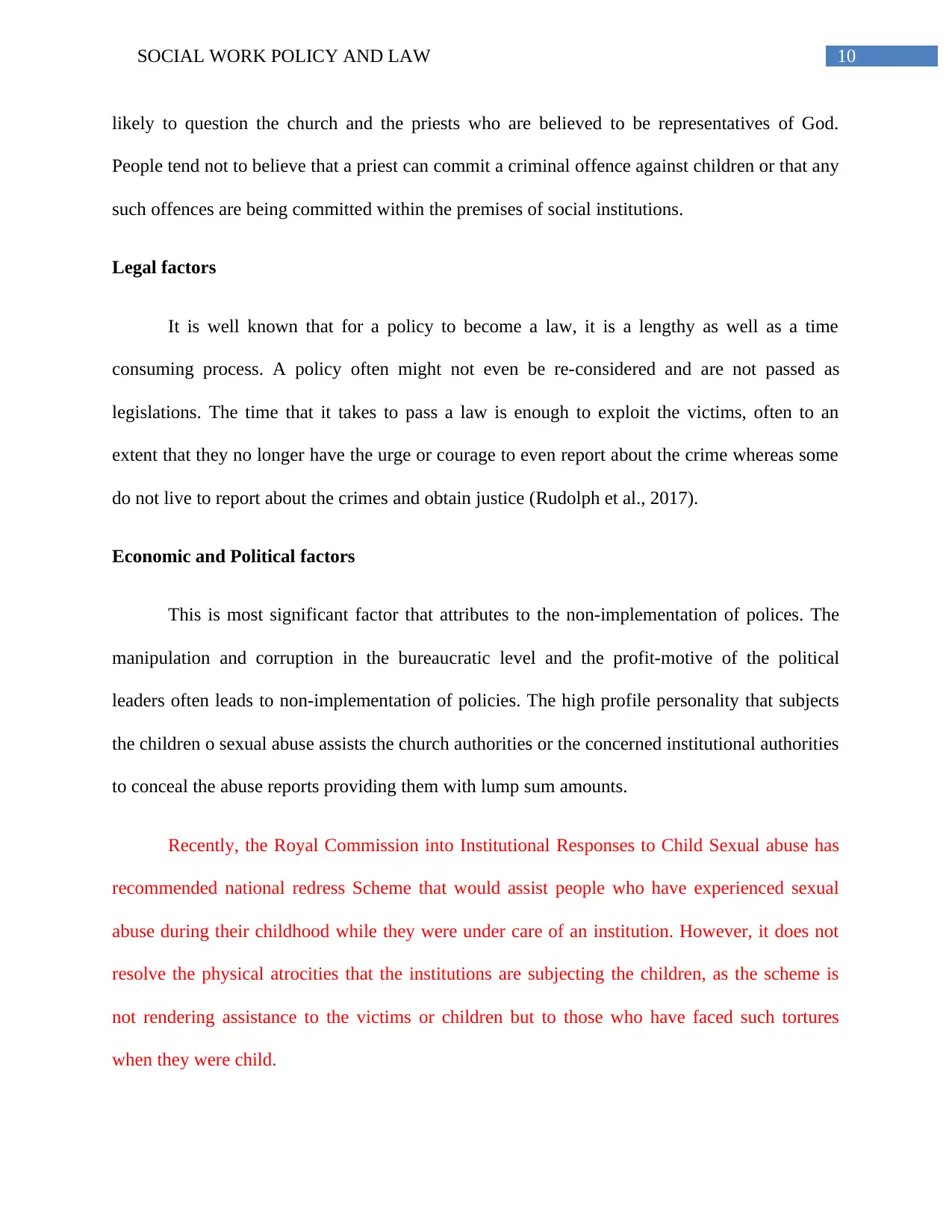
10SOCIAL WORK POLICY AND LAW
likely to question the church and the priests who are believed to be representatives of God.
People tend not to believe that a priest can commit a criminal offence against children or that any
such offences are being committed within the premises of social institutions.
Legal factors
It is well known that for a policy to become a law, it is a lengthy as well as a time
consuming process. A policy often might not even be re-considered and are not passed as
legislations. The time that it takes to pass a law is enough to exploit the victims, often to an
extent that they no longer have the urge or courage to even report about the crime whereas some
do not live to report about the crimes and obtain justice (Rudolph et al., 2017).
Economic and Political factors
This is most significant factor that attributes to the non-implementation of polices. The
manipulation and corruption in the bureaucratic level and the profit-motive of the political
leaders often leads to non-implementation of policies. The high profile personality that subjects
the children o sexual abuse assists the church authorities or the concerned institutional authorities
to conceal the abuse reports providing them with lump sum amounts.
Recently, the Royal Commission into Institutional Responses to Child Sexual abuse has
recommended national redress Scheme that would assist people who have experienced sexual
abuse during their childhood while they were under care of an institution. However, it does not
resolve the physical atrocities that the institutions are subjecting the children, as the scheme is
not rendering assistance to the victims or children but to those who have faced such tortures
when they were child.
likely to question the church and the priests who are believed to be representatives of God.
People tend not to believe that a priest can commit a criminal offence against children or that any
such offences are being committed within the premises of social institutions.
Legal factors
It is well known that for a policy to become a law, it is a lengthy as well as a time
consuming process. A policy often might not even be re-considered and are not passed as
legislations. The time that it takes to pass a law is enough to exploit the victims, often to an
extent that they no longer have the urge or courage to even report about the crime whereas some
do not live to report about the crimes and obtain justice (Rudolph et al., 2017).
Economic and Political factors
This is most significant factor that attributes to the non-implementation of polices. The
manipulation and corruption in the bureaucratic level and the profit-motive of the political
leaders often leads to non-implementation of policies. The high profile personality that subjects
the children o sexual abuse assists the church authorities or the concerned institutional authorities
to conceal the abuse reports providing them with lump sum amounts.
Recently, the Royal Commission into Institutional Responses to Child Sexual abuse has
recommended national redress Scheme that would assist people who have experienced sexual
abuse during their childhood while they were under care of an institution. However, it does not
resolve the physical atrocities that the institutions are subjecting the children, as the scheme is
not rendering assistance to the victims or children but to those who have faced such tortures
when they were child.
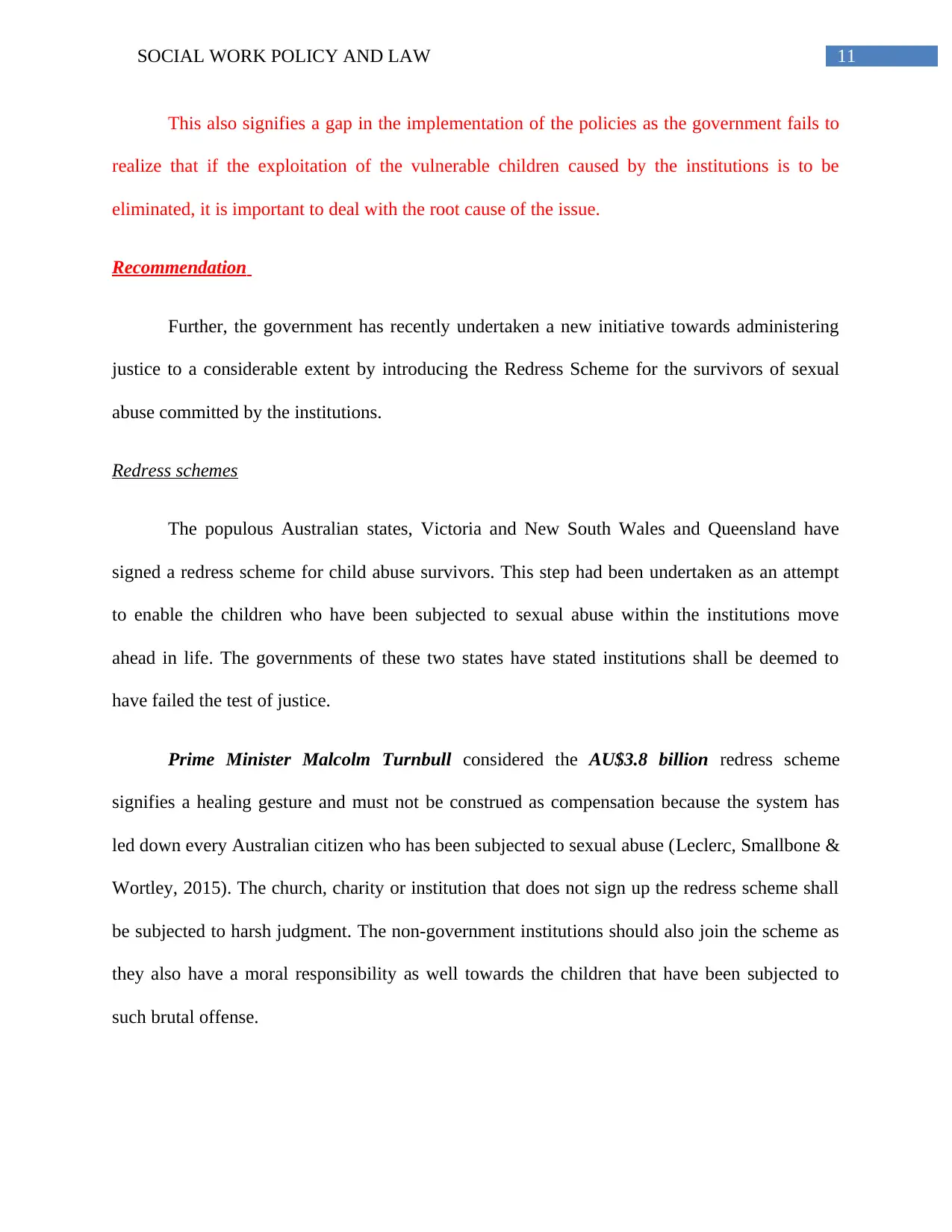
11SOCIAL WORK POLICY AND LAW
This also signifies a gap in the implementation of the policies as the government fails to
realize that if the exploitation of the vulnerable children caused by the institutions is to be
eliminated, it is important to deal with the root cause of the issue.
Recommendation
Further, the government has recently undertaken a new initiative towards administering
justice to a considerable extent by introducing the Redress Scheme for the survivors of sexual
abuse committed by the institutions.
Redress schemes
The populous Australian states, Victoria and New South Wales and Queensland have
signed a redress scheme for child abuse survivors. This step had been undertaken as an attempt
to enable the children who have been subjected to sexual abuse within the institutions move
ahead in life. The governments of these two states have stated institutions shall be deemed to
have failed the test of justice.
Prime Minister Malcolm Turnbull considered the AU$3.8 billion redress scheme
signifies a healing gesture and must not be construed as compensation because the system has
led down every Australian citizen who has been subjected to sexual abuse (Leclerc, Smallbone &
Wortley, 2015). The church, charity or institution that does not sign up the redress scheme shall
be subjected to harsh judgment. The non-government institutions should also join the scheme as
they also have a moral responsibility as well towards the children that have been subjected to
such brutal offense.
This also signifies a gap in the implementation of the policies as the government fails to
realize that if the exploitation of the vulnerable children caused by the institutions is to be
eliminated, it is important to deal with the root cause of the issue.
Recommendation
Further, the government has recently undertaken a new initiative towards administering
justice to a considerable extent by introducing the Redress Scheme for the survivors of sexual
abuse committed by the institutions.
Redress schemes
The populous Australian states, Victoria and New South Wales and Queensland have
signed a redress scheme for child abuse survivors. This step had been undertaken as an attempt
to enable the children who have been subjected to sexual abuse within the institutions move
ahead in life. The governments of these two states have stated institutions shall be deemed to
have failed the test of justice.
Prime Minister Malcolm Turnbull considered the AU$3.8 billion redress scheme
signifies a healing gesture and must not be construed as compensation because the system has
led down every Australian citizen who has been subjected to sexual abuse (Leclerc, Smallbone &
Wortley, 2015). The church, charity or institution that does not sign up the redress scheme shall
be subjected to harsh judgment. The non-government institutions should also join the scheme as
they also have a moral responsibility as well towards the children that have been subjected to
such brutal offense.
⊘ This is a preview!⊘
Do you want full access?
Subscribe today to unlock all pages.

Trusted by 1+ million students worldwide
1 out of 16
Related Documents
Your All-in-One AI-Powered Toolkit for Academic Success.
+13062052269
info@desklib.com
Available 24*7 on WhatsApp / Email
![[object Object]](/_next/static/media/star-bottom.7253800d.svg)
Unlock your academic potential
Copyright © 2020–2025 A2Z Services. All Rights Reserved. Developed and managed by ZUCOL.





